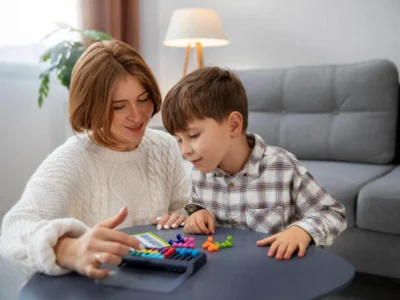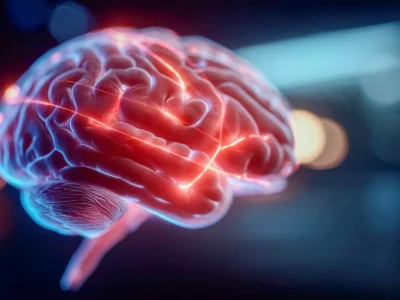Neuropsychologist Ana Laura Utrilla Lack reveals in this article the importance of psychoeducation for family members of people affected by frontotemporal dementia.
Living with and caring for a person with dementia can be a major challenge. Psychoeducation helps the family understand what is happening and how to manage it. In the case of frontotemporal dementia, the most prominent symptoms are related to changes in behavior. In addition, the patient is not fully aware of the changes in their behavior, which further complicates interaction with the family.
What is frontotemporal dementia?
The first step in psychoeducation is knowing what frontotemporal dementia is, behavioral variant. This is a type of dementia that occurs when there is damage to the frontal lobe.
The frontal lobe plays a key role in regulating behavior, attention, inhibition, and decision-making. Therefore, when this area is altered, the symptoms are mainly behavioral.
There are different types of frontotemporal dementia. One of them is the behavioral variant, which occurs when the lesion is specifically in the bilateral orbitofrontal cortex.
What does a patient with frontotemporal dementia look like?
As mentioned, a patient with frontotemporal dementia mainly shows changes in behavior and personality. Among these changes, the following can be observed:
- Extreme apathy, lack of emotionality, loss of interest in things they previously enjoyed.
- Neglect of personal hygiene and grooming. Patients may resist bathing and caring for their appearance. Even if prompted to do so, they may show anger and displeasure.
- Inappropriate behaviors, such as being overly direct in conversations or talking about inappropriate topics in unsuitable settings.
- Disinhibited behaviors in sexual contexts or in the expression of emotions.
- Obscene comments or behaviors.
- Emotional lability. That is, they may change emotions easily, without an apparent trigger.
- Irritability. They may be poorly tolerant and erupt easily.
- Inappropriate displays of emotion. Whether they are very happy, angry, or sad, the expression of these emotions may not fit the situation.
- Impulsivity, which can manifest as alcohol or substance use, excessive spending, or traffic accidents.
- Changes in appetite. The tendency is mainly to eat more than they used to, but there are also differences in how they eat, as there may be a preference for sweet or unhealthy foods. In addition, the amount and timing of meals are altered.
- Repetitive or stereotyped motor behaviors. Movements that do not have a specific goal or function and which the person continues doing without being able to stop. Some of these behaviors can be rocking, moving the mouth as if eating or chewing gum, or clapping, among others.
- Another important symptom is lack of awareness of the illness.
All of the symptoms or behaviors already mentioned can be noticeable to family and friends, who may try to approach the patient and attempt to change or correct the observed behaviors. However, the patient may show significant resistance to this and may even become angry or uncomfortable at what they perceive as an attack. This is because they are not able to perceive their own behaviors and how these have changed.
Who is involved in the diagnosis of frontotemporal dementia?
The diagnosis is a fundamental part of appropriate intervention. Hence the importance that once family members notice significant changes in the patient’s behavior, they consult the appropriate specialist.
Different specialists may be involved in the diagnosis of this type of disorder. Among them are the following:
- Neuropsychologist: The neuropsychologist is responsible for administering tests that assess executive functions associated with the frontal cortical area, which, as mentioned, is the area mainly affected in this dementia. It is also important to assess the functioning of the rest of the cognitive functions to make an adequate differential diagnosis.
- Geriatrician: The role of the geriatrician, as an internist specializing in older adults, is to assess not only behavior and cognition but the patient holistically, that is, their health status and the medications they take, in order to understand what is causing the frontal cortical alteration. The geriatrician, in turn, relies on neuroimaging tools to determine the state of the brain.
- Psychiatrist: Sometimes, because the changes are behavioral and personality-related, the first contact is with the psychiatrist. They conduct an evaluation to understand the patient’s emotional and cognitive state, which allows them to identify the symptoms and determine whether it is frontotemporal dementia. Like the geriatrician, they may use neuroimaging techniques to corroborate their diagnosis.
The three specialties mentioned can carry out the diagnosis of frontotemporal dementia. Sometimes, to reach a more accurate diagnosis, they work collaboratively among the three areas, each contributing different strategies for intervention.

Subscribe
to our
Newsletter
The diagnosis is confirmed… What next?
Once the diagnosis of frontotemporal dementia has been confirmed, it is important to begin intervention.
Usually, an intervention focuses only on the patient, but ideally it should also include the family.
Regarding the work with the patient, as with diagnosis, different specialists are involved:
- Neuropsychologist: in these cases, the neuropsychologist implements a specialized program focused on the needs identified in the initial assessment, providing tools to improve self-control, symptom management, etc.
- Medical treatment, either by the geriatrician or psychiatrist. The medical approach includes the use of medications to manage problematic behaviors identified in the patient.
As already mentioned, working with the family is also an important part, and this mainly consists of psychoeducation.
Psychoeducation with family members aims to provide them with information about the pathology so they know what it is, what to expect, how it will progress, and what they can do to better manage the situation. This has an important positive impact on both the patient and the caregiver, as it helps prevent caregiver burnout syndrome.
Part of psychoeducation involves the family learning what the dementia entails. But it is also very important to understand why the patient behaves the way they do.
When we have a patient who physically shows no impairment — that is, who walks well, talks well, has no mobility problems, etc. — family members find it difficult to understand that the observed behaviors are caused by organic damage and are not behaviors the patient can identify and regulate on their own.
At times, one of the greatest difficulties observed is in family relationships, since by acting impulsively or disinhibitedly, family members may feel offended by the patient, creating distance between them.
Some recommendations for family members of patients with frontotemporal dementia are:
- Carefully observe the patient, identify which situations trigger behavioral symptoms, and keep a record of them so they can be avoided at other times.
- Remove environmental cues that may trigger a crisis. For example, if the patient is not allowed to drive, do not leave the car keys within reach.
- Maintain a calm environment.
- Establish routines. Initially accompany and support the patient and, as the routines become more automatic, allow them to carry them out with greater independence.
- Simplify activities of daily living so they can continue doing them on their own.
- When harmful behaviors occur, distract the patient and redirect their attention to another stimulus that may interest them.
- If the patient is in crisis, remain calm, speak to them quietly while waiting for it to pass, and do not rush or force them, as that can upset them even more. If they are about to lose control, it is better to ask someone else to help.
Conclusion
When working with dementia, in this case frontotemporal dementia, it is important not only to address the patient but also to work with the family. Working with the family consists of providing psychoeducation or sharing important information for interacting with the patient. Knowing the tools they can use to communicate assertively or how to regulate the patient’s conflictive behaviors can improve not only the patient’s stability but also the family’s.
Bibliography
- Iragorri Cucalón, Ángela María. (2007). Frontotemporal dementia. Revista Colombiana de Psiquiatría, 36(Suppl. 1), 139-156.
- Lillo, P. (2016) Frontotemporal dementia, how the diagnosis has reemerged. Revista médica clínica Las Condes. 309-318 (May 2016)
If you liked this article about the importance of psychoeducation for family members of people affected by frontotemporal dementia, you will surely be interested in these NeuronUP articles:
“This article has been translated. Link to the original article in Spanish:”
Comprendiendo la demencia frontotemporal: La importancia de la psicoeducación para los familiares








Leave a Reply